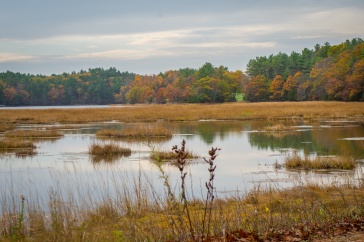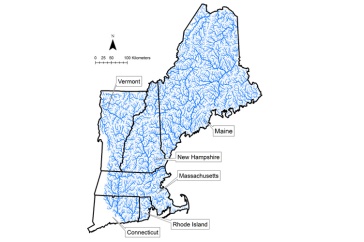
A curious trend is happening in some forests across New Hampshire: Trees are not growing as expected. Long-term datasets are showing that alongside the rapid rise of atmospheric carbon dioxide levels, trees have been taking up more carbon through photosynthesis — but measurements of their trunk circumferences suggest that wood growth has been slowing down, not increasing. So where is all that carbon going? Scott Ollinger, UNH professor of natural resources and the environment and director for the Earth Systems Research Center, says the contrast is intriguing, and he’s been awarded a three-year research grant to study this phenomenon that could have future impacts on the wood products industry and ecological food webs.
"These are interesting patterns that we haven't known how to explain, but they are consistent with this trend of rising carbon dioxide in our atmosphere."
With $298,237 from the Northeastern States Research Cooperative, Ollinger and colleagues from the Northeastern Research Station of USDA’s Forest Service, the University of Maine and the Woodwell Climate Research Center will investigate whether the decline of another important nutrient for plant growth — nitrogen — is contributing to the slowdown in wood production. They’ll also take a closer look at soil respiration to see if trees are putting more carbon underground into root growth instead of in their above-ground wood.
“These are interesting patterns that we haven’t known how to explain, but they are consistent with this trend of rising carbon dioxide in our atmosphere,” Ollinger says. “Plants take up carbon dioxide, so it should affect tree growth, but making use of the extra carbon also requires additional nitrogen. Trees may be investing more in their below-ground tissues as a way to meet that need.”
For this project, Ollinger will survey the nitrogen levels in tree foliage and examine the carbon-to-nitrogen ratio in soils of the Bartlett Experimental Forest in Bartlett, New Hampshire, and compare that data with the same types of measurements he collected 25 years prior. Combined with nearly 20 years of carbon flux data from towers in Bartlett and Howland, Maine, the research team will have a clearer picture of the long-term trends in growth and how trees are responding to rising atmospheric levels of carbon dioxide.
This research builds on his previous work published in Science that focused on the decline of nitrogen availability in plants.
As part of the same competitive grant funding cycle, the Northeastern States Research Cooperative also awarded $365,261 to Heidi Asbjornsen, UNH professor of natural resources and the environment. Asbjornsen’s project is titled, “Using a functional trait approach to inform assisted migration for climate adaption in the Northern Forest region.” The projects led by Asbjornsen and Ollinger were two of 18 funded projects totaling nearly $4.5 million in federal funding.
The UNH Institute for the Study of Earth, Oceans, and Space (EOS) is UNH's largest research enterprise, comprising six centers with a focus on interdisciplinary, high-impact research on Earth and climate systems, space science, the marine environment, seafloor mapping and environmental acoustics. With approximately 100 principal investigators managing more than 400 individual grant awards, and with annual expenditures exceeding $95 million, EOS fosters an intellectual and scientific environment that advances visionary scholarship and leadership in world-class and graduate education.
-
Written By:
Rebecca Irelan | Institute for the Study of Earth, Oceans, and Space | rebecca.irelan@unh.edu | 603-862-0990



















































